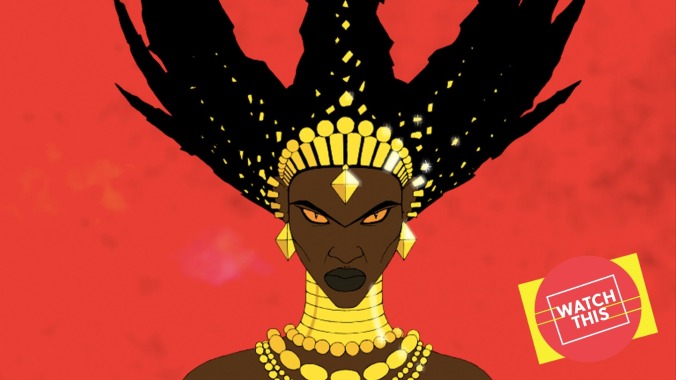This gorgeous folktale mashup will broaden horizons—and give kids a new favorite hero

Watch This offers movie recommendations inspired by new releases, premieres, current events, or occasionally just our own inscrutable whims. This week: With Raya And The Last Dragon, the new SpongeBob movie, and the half-cartoon Tom And Jerry all available this week, we’re looking back on some of the most underappreciated family-friendly animation.
Kirikou And The Sorceress (1998)
With the success of Black Panther having ignited an explosion of African-influenced pop culture in Western markets, there’s never been a more opportune time to get kids hooked on their new favorite hero, Kirikou! Super-fast, super-smart, super-tiny, and super-naked, he may not be the most physically imposing specimen, but he can save the day with the best of them. Not to mention that he’s got a theme song to rival Spider-Man’s, courtesy of Senegalese great Youssou N’Dour.
In Michel Ocelot’s gorgeously line-drawn fantasia Kirikou And The Sorceress, our hero begins his exploits as a fetus demanding to be freed from his mother’s womb, possessed of a hunger for life before he’s even begun his. He carries that indefatigable spirit into his self-assigned calling to return bounty and serenity to his once-lush village, now plagued by a drought and the malevolent, magnificent witch Karaba. This quest plays out like an episodic series of herculean tasks, accomplished through the classical traits of cunning, courage, and kindheartedness. Pint-size Kirikou hides in a hat and a crudely fashioned bird costume, bests a massive elephantine creature and an army of twitchy robots referred to as “fetishes,” matures, and falls in love.
Focus on the broad narrative contours linking the West African folktales that make up Ocelot’s film with every Campbellian epic from Perseus to Potter, and you’ll be taken off guard by the grand stylistic innovations, herky-jerky rhythms, and plainspoken communion with nature. All that sets it apart from the glut of youth-geared animation; this is how accessible a mythos and aesthetic steeped in the particulars of a particular region can be. Ocelot constructed the ideal bridge for adventurous junior cinephiles in search of cartoons that can challenge their understanding of the form without alienating them. Fun, funny, and visually splendorous, it provides an essential reminder that horizon-broadening ought to feel like a pleasure and privilege, not a homework assignment. (Even if it’s a staple of French class curricula.)
Born on the Riviera and raised in Guinea, the animator drew on his longstanding respect for African heritage and identity in conception and production, gathering a voice cast of local kids in Dakar to record all dialogue. In addition to the earworm title song, N’Dour contributed a score’s worth of nimble plucking and complex percussion as well. But Ocelot also cross-pollinated cultural specifics with artistic textures borrowed from an eclectic array of sources. He admired Edo-era woodblock prints and Egyptian artifacts, and fashioned Kirikou’s tunneling through a mountain after early German shadow-animation. Meanwhile, the toucan-flanked great hall of Karaba evokes the ornate extravagance of Fritz Lang’s Metropolis.
Ocelot’s joyous mashup is a work of uncommonly vivid imagination, sharing space with Yellow Submarine, Fantastic Planet, and The Triplets Of Belleville in the omnivorous grade-schooler’s alt-canon. Although its two sequels grew progressively less appealing, with 2012’s Kirikou And The Men And Women in eye-searing computerized 3D, the original stands as a valuable introduction to African cinema. That it would come from a white European’s perspective, however rooted in experience, may be the film’s key advantage and its major limitation. Ocelot sees through the vantage of a studious outsider, a standpoint some viewers will share—and hopefully, ultimately, venture beyond.
Availability: Kirikou And The Sorceress is currently streaming on Amazon Prime (in a low-quality English-language dub only, with English subtitles also burned in) and the Criterion Channel (in higher quality, with the original French audio). It’s also available to rent or purchase from Amazon.